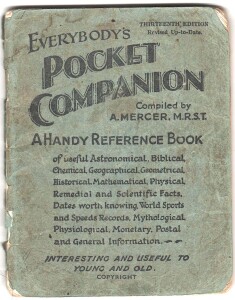The world has certainly changed since 1943. Everybody’s Pocket Companion, a handy paperback of some eighty pages compiled by someone called A. Mercer during the Second World War, dishes out a variety of ‘ useful ‘ facts on astronomy, geography, chemistry and sport, among other topics. While some things remain the same, the world’s political geography has altered considerably since the booklet was published. Here are a few examples:
EUROPE
Albania was annexed by Italy in April 1939. It became a communist state after the War and is now a sovereign nation again.
The Irish Free State was designated a Dominion governed by a Governor-General. It later became a Republic with a President.
Lithuania’s, capital was Kovno. It is now Vilnius and the old capital is now spelt Kaunus.
ASIA
Alexandretta’s,capital was Alexandretta. This now forms a part of modern SE Turkey.
China’s, capital was Nanking, which is now spelt Nanjing. Beijing is the current capital, thanks to Mao Tse Tung.
Malaya’s capital was Singapore. The capital of the ‘ Malay States ‘in 1943 was Kuala Lumpur. Malaya and the Malay States were amalgamated and became Malaysia, with Kuala Lumpur as the new capital. Singapore is now a separate entity.
Manchukuo (Manchuria’s), capital was Hsinking, which is now spelt Changchun. Manchuria/Manchukuo no longer exist as names. The province of Dongbei has replaced them.
Sinkiang( W. China), had a capital at Urumtsi, which is still the capital but is now spelt Urumqi. Sinkiang is now spelt Xinjiang.
Syriaand Lebanon’s,capital was Beirut. These are now separate countries, with Damascus as the capital of Syria.
AFRICA
Ashanti’s capital was Kumasi. Ashanti is now part of Ghana.
Basutoland’s, capital was Maseru. Basutoland is now known as Lesotho, but the capital is still Maseru
Bechuanaland’s, capital was Mafeking. Bechuanaland is now known as Botswana and the capital is now Gaborone. Mafeking (or Mafiking) is now over the border in South Africa.
Cyrenaica, an Italian colony on the coast of north Africa, had its capital at Benghazi. It later became part of the present day Libya.
Dahomey’s capital was Porto Novo. This former French colony in West Africa later achieved independence and is now known as Benin.
French Equatorial Africa became Gabon, but its capital is still Libreville
French Sudan achieved its independence and became Mali but its capital is still Bamako. Why it was called ‘Sudan’, when that country is several hundred miles away is not known.
Gambia’s capital in 1943 was Bathurst. It was renamed Banjul on independence
The Gold Coast achieved its independence and became Ghana.
Morocco’s capital was Fez. On independence from France it was shifted to Rabat.
Mozambique’s capital was Beira. This was later shifted to the much larger Lourenco Marques, the capital of Portuguese East Africa, which had been absorbed into Mozambique. Lourenco Marques was later renamed Maputo.
Nigeria’s capital was Lagos until Abuja, a planned city in the centre of the country, became the new capital.
Nyasaland became Malawi on independence and its old capital of Zomba was replaced by the much larger Lilongwe.
Rio de Oro, a Spanish colony in 1943, achieved its independence as Western Sahara and with El Aaiun as the new capital.
Senegal, a French colony with its capital at historic Port Louis. On achieving independence the capital was switched to the much larger Dakar, a hundred miles down the coast.
Togoland, a French colony,became Togo.
Tunis, another French colony, later became Tunisia.
ENGLISH COUNTY TOWNS
Cornwall’s county town was then Bodmin. It is now Truro.
Derbyshire ‘s county town was Derby. It is now Matlock.
Northumberland’s county town was Newcastle. It is now Morpeth.
Surrey’s county town was Guildford. It is now Kingston-on-Thames.
Wiltshire’s county town was Salisbury. It is now Trowbridge.
Yorkshire was one county in 1943 with York as the county town. In 1974 it was divided into four administrative areas– South Yorkshire ,West Yorkshire, North Yorkshire and Humberside. South Yorkshire and West Yorkshire were later parcelled out into unitary authorities and the unpopular Humberside was abolished. Only North Yorkshire retains Northallerton as its county town. [R.M.Healey]

